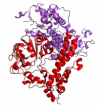Identification of restriction endonuclease with potential ability to cleave the HSV-2 genome: inherent potential for biosynthetic versus live recombinant microbicides
- PMID: 18687114
- PMCID: PMC2526989
- DOI: 10.1186/1742-4682-5-18
Identification of restriction endonuclease with potential ability to cleave the HSV-2 genome: inherent potential for biosynthetic versus live recombinant microbicides
Abstract
Background: Herpes Simplex virus types 1 and 2 are enveloped viruses with a linear dsDNA genome of approximately 120-200 kb. Genital infection with HSV-2 has been denoted as a major risk factor for acquisition and transmission of HIV-1. Developing biomedical strategies for HSV-2 prevention is thus a central strategy in reducing global HIV-1 prevalence. This paper details the protocol for the isolation of restriction endunucleases (REases) with potent activity against the HSV-2 genome and models two biomedical interventions for preventing HSV-2.
Methods and results: Using the whole genome of HSV-2, 289 REases and the bioinformatics software Webcutter2; we searched for potential recognition sites by way of genome wide palindromics. REase application in HSV-2 biomedical therapy was modeled concomitantly. Of the 289 enzymes analyzed; 77(26.6%) had potential to cleave the HSV-2 genome in > 100 but < 400 sites; 69(23.9%) in > 400 but < 700 sites; and the 9(3.1%) enzymes: BmyI, Bsp1286I, Bst2UI, BstNI, BstOI, EcoRII, HgaI, MvaI, and SduI cleaved in more than 700 sites. But for the 4: PacI, PmeI, SmiI, SwaI that had no sign of activity on HSV-2 genomic DNA, all 130(45%) other enzymes cleaved < 100 times. In silico palindromics has a PPV of 99.5% for in situ REase activity (2) Two models detailing how the REase EcoRII may be applied in developing interventions against HSV-2 are presented: a nanoparticle for microbicide development and a "recombinant lactobacillus" expressing cell wall anchored receptor (truncated nectin-1) for HSV-2 plus EcoRII.
Conclusion: Viral genome slicing by way of these bacterially- derived R-M enzymatic peptides may have therapeutic potential in HSV-2 infection; a cofactor for HIV-1 acquisition and transmission.
Figures




Similar articles
-
Identity of zinc finger nucleases with specificity to herpes simplex virus type II genomic DNA: novel HSV-2 vaccine/therapy precursors.Theor Biol Med Model. 2011 Jun 24;8:23. doi: 10.1186/1742-4682-8-23. Theor Biol Med Model. 2011. PMID: 21702927 Free PMC article.
-
Genital recurrent infection occurring 6 months after meningitis due to the same herpes simplex virus type 2 (HSV-2) strain evidence by restriction endonuclease analysis.J Infect. 1998 Mar;36(2):233-5. doi: 10.1016/s0163-4453(98)80024-8. J Infect. 1998. PMID: 9570665
-
Vaccines and microbicides preventing HIV-1, HSV-2, and HPV mucosal transmission.J Invest Dermatol. 2010 Feb;130(2):352-61. doi: 10.1038/jid.2009.227. Epub 2009 Oct 15. J Invest Dermatol. 2010. PMID: 19829304 Review.
-
Mechanistic Studies of Viral Entry: An Overview of Dendrimer-Based Microbicides As Entry Inhibitors Against Both HIV and HSV-2 Overlapped Infections.Med Res Rev. 2017 Jan;37(1):149-179. doi: 10.1002/med.21405. Epub 2016 Aug 12. Med Res Rev. 2017. PMID: 27518199 Review.
-
Dual-strain genital herpes simplex virus type 2 (HSV-2) infection in the US, Peru, and 8 countries in sub-Saharan Africa: A nested cross-sectional viral genotyping study.PLoS Med. 2017 Dec 27;14(12):e1002475. doi: 10.1371/journal.pmed.1002475. eCollection 2017 Dec. PLoS Med. 2017. PMID: 29281620 Free PMC article.
Cited by
-
Zinc finger arrays binding human papillomavirus types 16 and 18 genomic DNA: precursors of gene-therapeutics for in-situ reversal of associated cervical neoplasia.Theor Biol Med Model. 2012 Jul 28;9:30. doi: 10.1186/1742-4682-9-30. Theor Biol Med Model. 2012. PMID: 22840184 Free PMC article.
-
Proviral HIV-genome-wide and pol-gene specific zinc finger nucleases: usability for targeted HIV gene therapy.Theor Biol Med Model. 2011 Jul 22;8:26. doi: 10.1186/1742-4682-8-26. Theor Biol Med Model. 2011. PMID: 21781315 Free PMC article.
-
In silico evidence for the species-specific conservation of mosquito retroposons: implications as a molecular biomarker.Theor Biol Med Model. 2009 Jul 29;6:14. doi: 10.1186/1742-4682-6-14. Theor Biol Med Model. 2009. PMID: 19640272 Free PMC article.
-
Identity of zinc finger nucleases with specificity to herpes simplex virus type II genomic DNA: novel HSV-2 vaccine/therapy precursors.Theor Biol Med Model. 2011 Jun 24;8:23. doi: 10.1186/1742-4682-8-23. Theor Biol Med Model. 2011. PMID: 21702927 Free PMC article.
-
Targeted DNA mutagenesis for the cure of chronic viral infections.J Virol. 2012 Sep;86(17):8920-36. doi: 10.1128/JVI.00052-12. Epub 2012 Jun 20. J Virol. 2012. PMID: 22718830 Free PMC article. Review.
References
-
- UNAIDS Report on the global HIV-AIDS epidemic. 2006.
-
- Anderson RM. Transmission dynamics of sexually transmitted infections. In: Holmes KK, Sparling PF, Mårdh P-A, Lemon SM, Stamm WE, Piot P, et al, editor. Sexually transmitted diseases. 3. Chapter 3. New York: McGraw-Hill; 1999. pp. 25–37.
-
- Hillier SL. The vaginal microbial ecosystem and resistance to HIV. AIDS Res Hum Retrovir. 1998;14:S17–21. - PubMed
Publication types
MeSH terms
Substances
LinkOut - more resources
Full Text Sources
Miscellaneous

